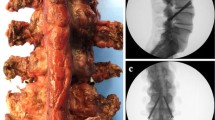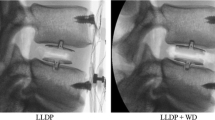Abstract
Study Design
In vitro biomechanical analysis.
Objectives
Compare the destabilizing effects of anterior discectomy to posterior spinal releases.
Summary of Background Data
Posterior release and pedicle screw fixation has become the accepted form of treatment for lumbar and thoracolumbar pediatric scoliotic spinal deformity. A biomechanical evaluation of posterior releases with comparison to traditional anterior releases has not been reported in the lumbar spine.
Methods
Eleven fresh-frozen human thoracolumbar specimens (T9—L5) were tested by a robotic manipulator (Staubli RX90; moment target of 5.0 Nm, force target of 50 N) in axial rotation (AR), plus lateral and anterior translation (LT and AT). Specimens underwent either sequential anterior release (partial and full discectomy) or posterior release (inferior facetectomy and wide posterior release) from T10 to L4. Partial discectomy retained the posterior 50% of disc and posterior longitudinal ligament, whereas full discectomy removed all of the disc and PLL. Wide posterior release included total facetectomy plus ligamentum flavum and spinous process resection.
Results
Inferior facetectomy produced an average increase of 1.5° ± 1.0° (p = .0625), 1.0 ± 0.8 mm (p = .0313), and 0.2 ± 0.3 mm (p =.156) in AR, LT, and AT, respectively. Compared with partial facetectomy, wide posterior release produced an average additional increase of 8.1° ± 4.0° (p = .0312), 2.0 ± 2.2 mm (p = .4062), and 1.1 ± 1.0 mm (p = .0625) in AR, LT, and AT, respectively. Full discectomy produced 201%, 161%, and 153% of the motion relative to wide posterior release in AR, LT, and AT, respectively (p = .0043, .0087, and .0173). Partial discectomy and wide posterior release proved statistically equivalent.
Conclusions
Wide posterior release of the thoracolumbar spine allows significant correction and may be superior to inferior facetectomy in axial rotation. Although complete discectomy with PLL resection would likely allow greater correction, a more clinically realistic partial discectomy confers similar corrective potential in vitro compared with wide posterior release.
Level of Evidence
Not applicable.
Similar content being viewed by others
References
Burton DC, Asher MA, Lai SM. Patient-based outcomes analysis of patients with single torsion thoracolumbar-lumbar scoliosis treated with anterior or posterior instrumentation: an average 5- to 9-year follow-up study. Spine (Phila Pa 1976) 2002;27:2363–7.
Geck MJ, Rinella A, Hawthorne D, et al. Comparison of surgical treatment in Lenke 5C adolescent idiopathic scoliosis: anterior dual rod versus posterior pedicle fixation surgery: a comparison of two practices. Spine (Phila Pa 1976) 2009;34:1942–51.
Barr SJ, Schuette AM, Emans JB. Lumbar pedicle screws versus hooks. Results in double major curves in adolescent idiopathic scoliosis. Spine (Phila Pa 1976) 1997;22:1369–79.
Hamill CL, Lenke LG, Bridwell KH, et al. The use of pedicle screw fixation to improve correction in the lumbar spine of patients with idiopathic scoliosis. Is it warranted? Spine (Phila Pa 1976) 1996;21:1241–9.
Hee HT, Yu ZR, Wong HK. Comparison of segmental pedicle screw instrumentation versus anterior instrumentation in adolescent idiopathic thoracolumbar and lumbar scoliosis. Spine (Phila Pa 1976) 2007;32:1533–42.
Halm H, Niemeyer T, Link T, Liljenqvist U. Segmental pedicle screw instrumentation in idiopathic thoracolumbar and lumbar scoliosis. Eur Spine J 2000;9:191–7.
Andras LM, Joiner ER, McCarthy RE, et al. Growing rods versus shilla growth guidance: better Cobb angle correction and T1-S1 length increase but more surgeries. Spine Deform 2015;3:246–52.
Shufflebarger HL, Clark CE. Effect of wide posterior release on correction in adolescent idiopathic scoliosis. J Pediatr Orthop B 1998;7:117–23.
Geck MJ, Macagno A, Ponte A, Shufflebarger HL. The Ponte procedure: posterior only treatment of Scheuermann’s kyphosis using segmental posterior shortening and pedicle screw instrumentation. J Spinal Disord Tech 2007;20:586–93.
Wang C, Bell K, McClincy M, et al. Biomechanical comparison of Ponte osteotomy and discectomy. Spine (Phila Pa 1976) 2015;40: E141–5.
Wollowick AL, Farrelly EE, Meyers K, et al. Anterior release generates more thoracic rotation than posterior osteotomy: a biomechanical study of human cadaver spines. Spine (Phila Pa 1976) 2013;38:1540–5.
Wiemann J, Durrani S, Bosch P. The effect of posterior spinal releases on axial correction torque: a cadaver study. J Child Orthop 2011;5:109–13.
Sangiorgio SN, Borkowski SL, Bowen RE, et al. Quantification of increase in three-dimensional spine flexibility following sequential Ponte osteotomies in a cadaveric model. Spine Deform 2013;1: 171–8.
Wilke HJ, Wenger K, Claes L. Testing criteria for spinal implants: recommendations for the standardization of in vitro stability testing of spinal implants. Eur Spine J 1998;7:148–54.
Bell KM, Hartman RA, Gilbertson LG, Kang JD. In vitro spine testing using a robot-based testing system: comparison of displacement control and hybrid control. J Biomech 2013;46:1663–9.
Bell KM, Oh A, Cook HA, et al. Adaptation of a clinical fixation device for biomechanical testing of the lumbar spine. J Biomech 2018;69:164–8.
Geck MJ, Rinella A, Hawthorne D, et al. Anterior dual rod versus posterior pedicle fixation surgery for the surgical treatment in Lenke 5C adolescent idiopathic scoliosis: a multicenter, matched case analysis of 42 patients. Spine Deform 2013;1:217–22.
Li M, Ni J, Fang X, et al. Comparison of selective anterior versus posterior screw instrumentation in Lenke5C adolescent idiopathic scoliosis. Spine (Phila Pa 1976) 2009;34:1162–6.
Hsu LC, Zucherman J, Tang SC, Leong JC. Dwyer instrumentation in the treatment of adolescent idiopathic scoliosis. J Bone Joint Surg Br 1982;64:536–41.
Dwyer AF, Newton NC, Sherwood AA. An anterior approach to scoliosis. A preliminary report. Clin Orthop Relat Res 1969;62:192–202.
Moe JH, Purcell GA, Bradford DS. Zielke instrumentation (VDS) for the correction of spinal curvature. Analysis of results in 66 patients. Clin Orthop Relat Res 1983;180:133–53.
Sweet FA, Lenke LG, Bridwell KH, Blanke KM. Maintaining lumbar lordosis with anterior single solid-rod instrumentation in thoracolumbar and lumbar adolescent idiopathic scoliosis. Spine (Phila Pa 1976) 1999;24:1655–62.
Lowe TG, Peters JD. Anterior spinal fusion with Zielke instrumentation for idiopathic scoliosis. A frontal and sagittal curve analysis in 36 patients. Spine (Phila Pa 1976) 1993;18:423–6.
Liebsch C, Graf N, Appelt K, Wilke HJ. The rib cage stabilizes the human thoracic spine: An in vitro study using stepwise reduction of rib cage structures. PLoS One 2017;12:e0178733.
Janssen MM, de Wilde RF, Kouwenhoven JW, Castelein RM. Experimental animal models in scoliosis research: a review of the literature. Spine J 2011;11:347–58.
McCarthy RE, Sucato D, Turner JL, et al. Shilla growing rods in a caprine animal model: a pilot study. Clin Orthop Relat Res 2010;468:705–10.
Author information
Authors and Affiliations
Corresponding author
Additional information
Author disclosures: BR (none), RR (none), MA (none), XW (none), NV (none), KMB (none), PB (none).
IRB Approval: No IRB approval was required or obtained for this work. Regulatory approval was obtained from the Office for Oversight of Anatomic Specimens (CORID#: 687).
Funding: Departmental grant funds were used for this work. No other grants or donations were utilized.
Rights and permissions
About this article
Cite this article
Rynearson, B., Ramanathan, R., Allen, M. et al. Biomechanical Analysis of Wide Posterior Releases Compared With Inferior Facetectomy and Discectomy in the Thoracolumbar and Lumbar Spine. Spine Deform 7, 404–409 (2019). https://doi.org/10.1016/j.jspd.2018.09.004
Received:
Revised:
Accepted:
Published:
Issue Date:
DOI: https://doi.org/10.1016/j.jspd.2018.09.004




